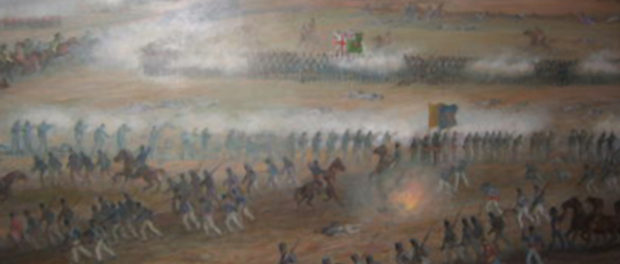1813: Crysler’s Farm & Other Quebec Curios
Part of “The Canadas in Britain”, 1792-1827
 Artistic depiction of the Battle of Crysler's Farm by Adam Sherriff-Scott. Photo credit: Historica Dominion
Artistic depiction of the Battle of Crysler's Farm by Adam Sherriff-Scott. Photo credit: Historica Dominion
Around the same time when Laura Secord aided the Niagara region of Upper Canada from falling into American hands, De Salaberry’s Voltigeurs were fending off the Americans from the western shores of the Saint Lawrence at Crysler’s Farm.
On the American side, James Wilkinson’s forces were arriving at Montreal by boat. Their plan was to take control of Montreal, thereby cutting off the major supply line for Upper Canada. They were joined by Wade Hampton’s forces that were marching towards Montreal. Wilkinson’s forces were to meet Hampton’s, join forces, and make their way up towards Montreal. Wilkinson, who had fallen ill and was on the medication of the day, had to delegate command to another officer, John Parker Boyd. Throughout Wilkinson and Boyd’s journey, there were squabbles between the two that further delayed their journey, making it easier for Morrison and his team of Voltigeurs and Native American allies to observe and plan their battle tactics.
British Joseph Morrison had the strength of De Salaberry’s Voltigeurs and Mohawk allies behind him, but they numbered at most around nine hundred people and relentlessly pursued Wilkinson’s forces as they made their way towards their meeting point with Hampton. Morrison, however, had another interesting ally: William Mulcaster and his fleet of ships sailing down to their aid. As the Americans slowly made their way towards their destination, Mulcaster would attack the Americans at night, attempting to destroy their boats. While it did not work, it aided the Canadian forces by further slowing them down. The night before the battle, Morrison and his troops stayed at John Crysler’s farmhouse, a British sympathiser, with many troops sleeping outside in what proved to be a cold and rainy night. As Wilkinson’s forces were arriving by boat, Morrison’s troops hid on the shores and shot at the Americans, antagonising the Americans to go onto the shores and fight them.
Their tactic worked, and the Americans went to shore to start the battle. Boyd and Hampton mistakenly underestimated the number of British soldiers and sent in less than half of their total soldiers to fight the battle on land, permitting a full Lower Canadian force to meet an already weakened American force that had no official tactical plan devised by either Boyd or Hampton. The battle was over in less than one day, with the Americans surrendering. To lessen the blow, Wilkinson attempted to frame the battle as nonetheless an American victory, though the Americans saw his ineptitude and he was disgraced.
The American defeat that year would be the Americans’ final attempt at conquering Montreal during the War of 1812.





